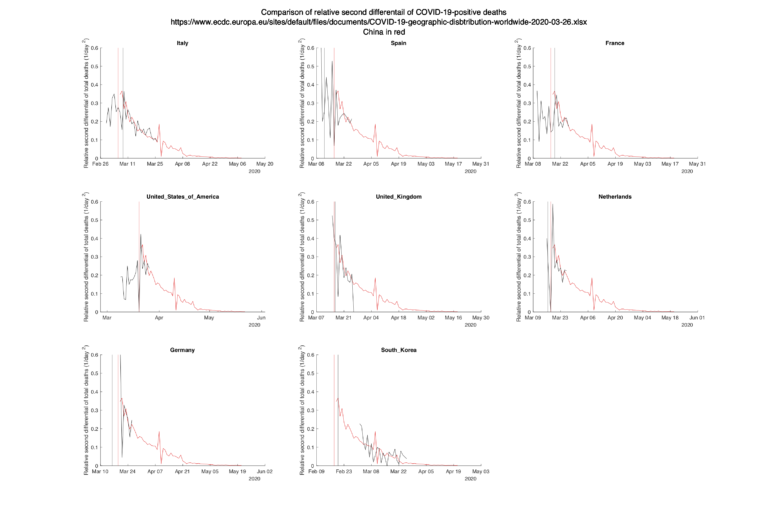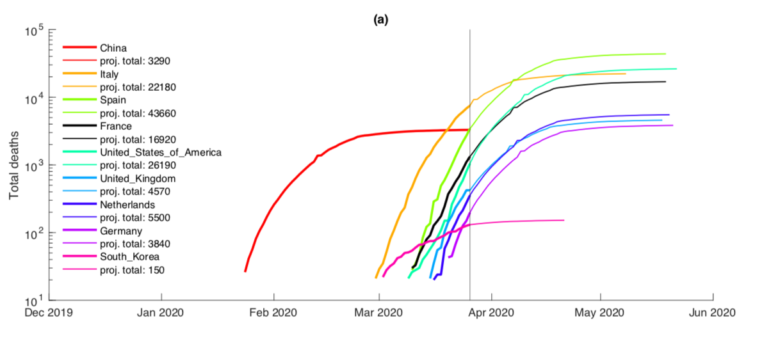The growth of the COVID-19 death rate is slowing down in countries as they practice social distancing, new analysis finds
As the number of deaths from COVID-19 increase across the world, people may be discouraged, wondering when this crisis will end and whether the social distancing measures put in place are actually working.
However, a new analysis of COVID-19 death rates shows that some countries are seeing a decline in the daily growth rate of deaths after implementing social distancing measures. This means that even when the number of deaths is still increasing, it increases more slowly. The decline in the growth rate of deaths follows the identical pattern seen in China after Wuhan was locked down.
The study, conducted by Professor Tom Pike of Imperial College London and Dr. Vikas Saini, President of the Lown Institute, is publicly available on the MedRxiv preprint server. Here are some of the key takeaways:
Social distancing works–the earlier, the better
Once countries implemented social distancing measures, their daily growth rate of deaths began to decrease. This suggests that interventions to increase social distancing are effective, even though different countries have implemented measures of different intensities. In addition, predictions of daily and total death rates calculated from the curves confirm that the sooner social distancing measures are put in place, the lower the total death toll.

“This gives us some cause for hope that social distancing over time will lead to extinguishing the spread of the virus,” said Dr. Vikas Saini. The similarity in death rate curves in China compared to Italy and other European countries suggests that Western democracies may be able to achieve the benefits of social distancing without resorting to the more aggressive lockdown measures implemented by China. Data are too early in the United States to be confident of the results here.
“Social distancing is doing everything we would want of it. The most important thing is to stay the course.”
Vikas Saini
However, these results do not indicate that countries that have implemented social distancing are in the clear and can stop these measures. “Social distancing is doing everything we would want of it. The most important thing is to stay the course,” said Saini.

Despite President Trump’s desire to relax social distancing by Easter, the evidence in this study does not support that timing for such a public health decision. In fact, according to the analysis, death rates in the US are predicted to peak in the days before Easter. “Trump’s timeline is way too early,” said Saini. “There is a concern that if you relax controls too quickly, death rates will start increasing again.”
COVID-19 deaths in the US may be on the lower end of predictions
Predictions of the total number of deaths from COVID-19 in the US have varied widely, with some researchers estimating 10,000 COVID-19 deaths in the U.S. and others estimating 2 million deaths. According to this new analysis, assuming that the U.S. adopts more widespread social distancing measures and keeps them in place, the total number of deaths in the U.S. will be around 26,000, which is on the lower end of previous predictions.
Saini notes that US data are limited at this point, and it may be too early to know whether the US is indeed on the “Wuhan Curve.” The US is different because there have been outbreaks in several different areas, and the policy response in each area has been somewhat different. This projection is a best case scenario if the US were to get on China’s trajectory, which will take a widespread effort to socially distance everywhere.

This finding is not to diminish the harm COVID-19 will cause to the American public and the health care system. In fact, this analysis confirms that we are following the pattern of deaths seen in Italy, for which we are not prepared. Currently, shortages of protective equipment, ICU beds, and ventilators already threaten to overwhelm hospitals in Washington State, California, and New York.
“There’s a light at the end of the tunnel, but we’re still in hell right now.”
Vikas Saini
“In the end, the total deaths from COVID-19 may not seem like a huge number compared to total annual deaths in the US (2.8 million in 2017), but it’s pretty frightening what it’s doing to the health of communities like New York. When this pandemic is over, we will have to do a huge reassessment of what works and doesn’t work in our health care system,” said Saini. “There’s a light at the end of the tunnel, but we’re still in hell right now.”
